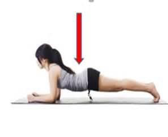Having spent the last 30 years as an instructor from Slide… yes Slide!! To Aerobics, Step, BodyPump, BodyBalance, Circuit training, you name it I have trained and taught it. Latterly preferring Pilates as my main passion.
I am intrigued with how the plank is presented in classes, traditionally Pilates have the ‘prone leg pull’ but the stationary plank is the big thing in many classes at the moment.
I have seen the plank taught really well with the instructor giving the benefits, alternatives and helping with technique, however I have also seen instructors starting the class with plank, no alternatives and the participants in what can only be described as a poor down dog.
Plank is an effective bodyweight exercise that can be done as part of any exercise routine as long as it isn’t held for excessive amounts of time, or executed incorrectly. Holding a plank for excessive amounts of time and/or having poor technique, can cause a condition known as costochondritis. This is caused by putting excessive pressure through the costochondral joint causing inflammation to the cartilage connecting the ribs to the sternum. The Plank is perfectly safe if executed well and with strength.
Down dog
BASIC PLANK
Here are my tips on how to get the best out of your class participants.
The setup is crucial and should always be the basic plank position bearing in mind that for some of your class will find the basic position difficult, give a couple of options.
BASIC PLANK
Take them on to all fours, hands and feet. Hands directly under the shoulders, push through the palms of the hands to activate pectoralis minor and serratus anterior which will help eliminate shoulder girdle winging and stabilise the shoulder girdle.
The plank on the elbows is an easier variation, same set up position but on the elbows, making sure that the elbows are aligned below the shoulders and the arms towards the floor, about shoulder distance apart, this is also a good alternative for participants with weak wrists.
 Take one leg back at a time and push though the heels
Take one leg back at a time and push though the heels- Hold still and pull your belly button up towards your spine
- Don’t dip the hips
- Head should be in line so look towards the end of your mat
As well as activating your core muscles you will also be firing your glutes, shoulders and arms.
You need to squeeze the glutes to stabilise and co-activate the muscles of the pelvis, local spine and shoulder girdle (centering) and visualise drawing your quads towards your elbows and your elbows to your quads, but with no movement. Hold to start with for 10 seconds and build it up gradually. Execute initially on your elbows or on your hands. Ensure perfect alignment.
The easy options for beginners to exercise would be on the distal quadricep muscles in an oblique plank alignment this allows them to perfect their form as there is less strain on the lower back.
The most common fault here is that they go on to all fours directly onto the knee cap, you need to coach them to move their body forward and give it length in the oblique position.
There are so many great add on’s to the basic plank but get the basic right first.
Some common faults to be aware of:-
- Letting the back dip, very common with people who can’t co-activate the core muscles and where the core muscles do not have the endurance to sustain activation. Build up from the easier position.
- The down dog position is not a plank, coach them slowly to drop their butt and get them to activate the core and engage their abdominals from the sternum to the pubic bone and squeeze the glutes to help stabilise.
- They have a lot to think about so the head will drop, get them to focus towards the end of their mat, the head and neck are part of the plank exercise.
- Breathing is crucial to help stay in the exercise and helps to stay longer without feeling faint or dizzy.
- You need to give them a visualisation to get them in the right position.
Dipping the back
Remember sometimes it’s good to go back to basics…..
Lorraine Young, Director UK Pilates Academy – Spain admin@ukpilatesacademy-spain.com
www.ukpilatesacademy-spain.com
Powered by Drummond Education


